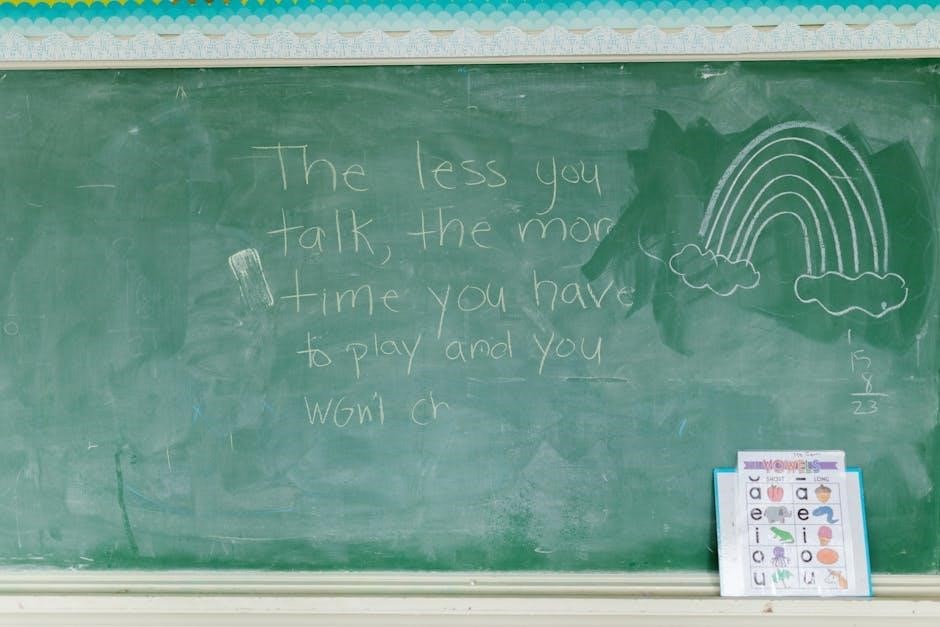Learning to read with phonics involves teaching letters and sounds in a specific order, using resources like Letters and Sounds programme and Edith Cowan University guides.
Importance of Phonics in Reading
The importance of phonics in reading cannot be overstated, as it provides children with the skills to decode and understand written language, enabling them to read with fluency and accuracy. Phonics instruction helps children to recognize the relationship between sounds and letters, and to apply this knowledge to read unfamiliar words. Effective phonics teaching is essential for children to become confident and proficient readers. By learning phonics, children can improve their reading comprehension, vocabulary, and spelling skills, which are all crucial for academic success; Phonics instruction is a critical component of reading instruction, and its importance should not be underestimated.

Phonics Phases and Sounds
Phonics phases include six distinct levels of sounds and letters taught progressively to children using various educational resources and guides online always available.
Overview of Phonics Phases
The phonics phases are designed to help children learn to read and write by teaching them the relationship between sounds and letters.
The phases are typically divided into six levels, each with its own set of skills and objectives, and are usually taught in a specific order to help children build on their previous knowledge and understanding.
The phases are an essential part of teaching phonics and are used in many schools and educational institutions to help children develop their reading and writing skills, with online resources available to support teachers and parents.
The phases provide a structured approach to teaching phonics, and are an effective way to help children learn to read and write.
The use of phonics phases has been shown to be highly effective in improving children’s literacy skills.
The phases are a key part of the phonics teaching approach, and are used to support children’s learning and development.
Phonics phases are used in conjunction with other teaching methods to provide a comprehensive approach to literacy education, and to help children achieve their full potential.
The phases are an important part of the educational process, and are used to help children develop the skills they need to succeed in school and beyond, with a focus on reading and writing skills.
The phonics phases are a valuable resource for teachers and parents, and are used to support children’s learning and development in a variety of settings, including schools and homes, and are an essential part of the educational process.
The phases provide a clear and structured approach to teaching phonics, and are an effective way to help children learn to read and write, and are used in many educational institutions around the world.
The use of phonics phases has been shown to be highly effective in improving children’s literacy skills, and are a key part of the phonics teaching approach, with a focus on providing a comprehensive approach to literacy education.
The phases are used to support children’s learning and development, and are an essential part of the educational process, with online resources available to support teachers and parents, and to help children achieve their full potential, and to provide a structured approach to teaching phonics.
The phonics phases are a key part of the educational process, and are used to help children develop the skills they need to succeed in school and beyond, with a focus on reading and writing skills, and are used in conjunction with other teaching methods to provide a comprehensive approach to literacy education.
The phases provide a clear and structured approach to teaching phonics, and are an effective way to help children learn to read and write, and are used in many educational institutions around the world, with online resources available to support teachers and parents, and to help children achieve their full potential.
The use of phonics phases has been shown to be highly effective in improving children’s literacy skills, and are a key part of the phonics teaching approach, with a focus on providing a comprehensive approach to literacy education, and are used to support children’s learning and development, and are an essential part of the educational process, with online resources available to support teachers and parents.
The phases are a valuable resource for teachers and parents, and are used to support children’s learning and development in a variety of settings, including schools and homes, and are an essential part of the educational process, with a focus on providing a comprehensive approach to literacy education, and are used in conjunction with other teaching methods to provide a comprehensive approach to literacy education, and to help children achieve their full potential, and to provide a structured approach to teaching phonics, and are used in many educational institutions around the world, with online resources available to support teachers and parents, and to help children achieve their full potential, and to provide a clear and structured approach to teaching phonics, and are an effective way to help children learn to read and write, and are used to support children’s learning and development, and are an essential part of the educational process, with online resources available to support teachers and parents, and to help children achieve their full potential, with a focus on reading and writing skills, and are used in conjunction with other teaching methods to provide a comprehensive approach to literacy education, and are a key part of the phonics teaching approach, with a focus on providing a comprehensive approach to literacy education, and are used to support children’s learning and development, and are an essential part of the educational process, with online resources available to support teachers and parents, and to help children achieve their full potential, with a focus on reading and writing skills.
The phases are used to support children’s learning and development, and are an essential part of the educational process, with online resources available to support teachers and parents, and to help children achieve their full potential, with a focus on reading and writing skills, and are used in conjunction with other teaching methods to provide a comprehensive approach to literacy education, and are a key part of the phonics teaching approach, with a focus on providing a comprehensive approach to literacy education, and are used to support children’s learning and development, and are an essential part of the educational process, with online resources available to support teachers and parents.
The use of phonics phases has been shown to be highly effective in improving children’s literacy skills, and are a key part of the phonics teaching approach, with a focus on providing a comprehensive approach to literacy education, and are used to support children’s learning and development, and are an essential part of the educational process, with online resources available to support teachers and parents, and to help children achieve their full potential.
The phases provide a clear and structured approach to teaching phonics, and are an effective way to help children learn to read and write, and are used in many educational institutions around the world, with online resources available to support teachers and parents, and to help children achieve their full potential, and to provide a structured approach to teaching phonics, and are used to support children’s learning and development, and are an essential part of the educational process.
The phases are a valuable resource for teachers and parents, and are used to support children’s learning and development in a variety of settings, including schools and homes, and are an essential part of the educational process, with a focus on providing a comprehensive approach to literacy education, and are used in conjunction with other teaching methods to provide a comprehensive approach to literacy education, and to help children achieve their full potential, and to provide a structured approach to teaching phonics, and are used in many educational institutions around the world.
The use of phonics phases has been shown to be highly effective in improving children’s literacy skills, and are a key part of the phonics teaching approach, with a focus on providing a comprehensive approach to literacy education, and are used to support children’s learning and development, and are an essential part of the educational process, with online resources available to support teachers and parents, and to help children achieve their full potential, with a focus on reading and writing skills, and are used in conjunction with other teaching methods to provide a comprehensive approach to literacy education.
The phases are used to support children’s learning and development, and are an essential part of the educational process, with online resources available to support teachers and parents, and to help children achieve their full potential, with a focus on reading and writing skills, and are used in conjunction with other teaching methods to provide a comprehensive approach to literacy education, and are a key part of the phonics teaching approach, with a focus on providing a comprehensive approach to literacy education, and are used to support children’s learning and development, and are an essential part of the educational process.
The phases provide a clear and structured approach to teaching phonics, and are an effective way to help children learn to read and write, and are used in many educational institutions around the world, with online resources available to support teachers and parents, and to help children achieve their full potential, and to provide a structured approach to teaching phonics, and are used to support children’s learning and development, and are an essential part of the educational process, with online resources available to support teachers and parents, and to help children achieve their full potential, with a focus on reading and writing skills.
The use of phonics phases has been shown to be highly effective in improving children’s literacy skills, and are a key part of the phonics teaching approach, with a focus on providing a comprehensive approach to literacy education, and are used to support children’s learning and development, and are an essential part of the educational process, with online resources available to support teachers and parents, and to help children achieve their full potential, with a focus on reading and writing skills, and are used in conjunction with other teaching methods to provide a comprehensive approach to literacy education, and are a key part of the phonics teaching approach, with a focus on providing a comprehensive approach to literacy education, and are used to support children’s learning and development, and are an essential part of the educational process.
The phases are a valuable resource for teachers and parents, and are used to support children’s learning and development in a variety of settings, including schools and homes, and are an essential part of the educational process, with a focus on providing a comprehensive approach to literacy education, and are used in conjunction with other teaching methods to provide a comprehensive approach to literacy education, and to help children achieve their full potential, and to provide a structured approach to teaching phonics, and are used in many educational institutions around the world, with online resources available to support teachers and parents, and to help children achieve their full potential, and to provide a clear and structured approach to teaching phonics, and are an effective way to help children learn to read and write, and are used to support children’s learning and development, and are an essential part of the educational process.
The phases provide a clear and structured approach to teaching phonics, and are an effective way to help children learn to read and write, and are used in many educational institutions around the world, with online resources available to support teachers and parents, and
Teaching Sequence and Materials
Edith Cowan University’s teaching sequence guides classroom teachers with quality phonics materials and resources for effective instruction and learning outcomes always matter.
Edith Cowan University’s Teaching Sequence
Edith Cowan University has published a teaching sequence based on the Letters and Sounds program, which provides a guide for classroom teachers to implement comprehensive phonics instruction. This sequence is designed to help teachers deliver high-quality phonics lessons and support students’ learning outcomes. The university’s teaching sequence is aligned with the recommendations of the Rose Review and is intended to be used in conjunction with other phonics resources. By following this sequence, teachers can ensure that their students receive a thorough and systematic phonics education, which is essential for reading and spelling development. The sequence includes a range of activities and strategies to support teaching and learning.

Phonics Teaching Order
Phonics teaching order involves systematic instruction of letters and sounds using guides like Letters and Sounds programme and Edith Cowan University resources always.
Order of Teaching Sounds
The order of teaching sounds is crucial in phonics instruction, with programs like Read Write Inc phonics introducing individual sounds in a specific sequence.
The teaching materials provide a structured approach to introducing sounds, with activities designed to help children learn and practice these sounds.
This systematic approach to teaching sounds helps children develop phonemic awareness and decoding skills, essential for reading and writing.
By following a structured order of teaching sounds, teachers can ensure that children build a strong foundation in phonics and develop into confident readers and writers.
This approach is supported by research and is widely used in schools, with resources like Letters and Sounds programme and Edith Cowan University guides providing teachers with a clear framework for instruction.

Sequence of Teaching
Teaching sequence is crucial for phonics instruction, using guides like Edith Cowan University’s sequence for effective teaching methods and resources always.
Discrete Phonics Sessions
Discrete phonics sessions are essential for effective phonics teaching, allowing for focused instruction and practice.
In these sessions, teachers can provide explicit teaching of phonics skills, such as sounding out words and identifying rhyming patterns.
The use of guides like Edith Cowan University’s sequence can help teachers plan and deliver these sessions, ensuring that students receive a comprehensive phonics education.
By incorporating discrete phonics sessions into their teaching practice, educators can help students develop a strong foundation in phonics and improve their overall reading ability.
This approach can be particularly beneficial for students who require extra support or review, as it allows for targeted instruction and reinforcement of key phonics skills.
Effective discrete phonics sessions can have a positive impact on student learning outcomes.

Phonics Scope and Sequence
Phonics scope and sequence guides provide teachers with a framework for planning instruction and assessment activities effectively always online.
Why a Phonics Scope and Sequence is Necessary
A phonics scope and sequence is necessary to ensure that teachers are providing a comprehensive and structured approach to phonics instruction. This helps to prevent gaps in learning and ensures that students are building on previous knowledge. A well-planned scope and sequence also enables teachers to assess student progress and identify areas where additional support is needed. By having a clear plan in place, teachers can be confident that they are covering all the necessary skills and concepts, and that students are receiving a high-quality phonics education. This in turn helps to improve student outcomes and increase reading proficiency. Effective phonics instruction is critical for reading success.
